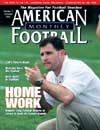Article CategoriesAFM Magazine
|
Running Out of the SpreadBy forcing the defense to show its formations and tendencies, teams using the spread offense have begun to run the ball wellby: Steve Silverman © More from this issue Northwestern has certainly had a long football history - but it has not usually been very glorious. The Wildcats first started to line up and play football back in 1882 and since that time they have put together a record of 412-563-43. A lot of head shaking and fist-banging has been done by their fans over the years. The team had endured 23 straight losing seasons heading into 1995 when a bit of magic dust was sprinkled over Evanston. The Wildcats suddenly got good and got nasty. They went from 3-7-1 the year before to 10-2, a Big Ten Championship and an appearance in the Rose Bowl vs. USC. Head coach Gary Barnett was viewed by most as a miracle worker. The team continued to roll the following year and won another Big Ten title with a 9-3 record before getting beat 48-28 by Tennessee in the Citrus Bowl. It appeared the Wildcats had ....The full article can only be seen by subscribers.
|
|
|||||||
| HOME |
MAGAZINE |
SUBSCRIBE | ONLINE COLUMNISTS | COACHING VIDEOS |
Copyright 2025, AmericanFootballMonthly.com
All Rights Reserved





